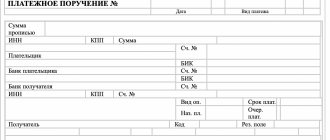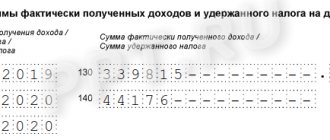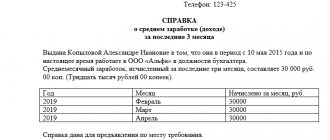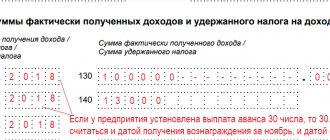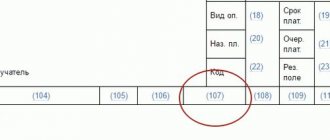- Availability of separate divisions
Payment of wages is accompanied by the need to calculate and pay personal income tax. This abbreviation stands for personal income tax, often referred to simply as income tax. This rule applies equally to all types of business entities - both individual entrepreneurs and legal entities.
In order to report to the fiscal authorities on the calculation of income tax, two types of reports are used - 6-NDFL and 2-NDFL. The first must be compiled and submitted to the Federal Tax Service every quarter, and the second - at the end of the year. The article describes in detail the most important points related to the report in form 6-NDFL - the rules of preparation, frequency and deadlines for submission, design features in different typical situations.
Definition and legal regulation
Form 6-NDFL is a relatively new type of mandatory reporting, which is used to provide information on personal income tax by all tax agents. The basic requirements for the calculation and execution of the document are determined by Order No. ММВ-7-11 / [email protected] , signed by the head of the Federal Tax Service of the Russian Federation on October 14, 2020. As of today, the version of the normative act approved by another departmental Order - No. ММВ-7-11 / [email protected] adopted on January 17, 2020 is in force.
6-NDFL is issued in two forms - paper or electronic. Currently, only those individual entrepreneurs and organizations with fewer than 25 employees have the right to apply the first option. If the specified quantity is exceeded, the report may be submitted exclusively in electronic format.
IMPORTANT. Starting in 2020, further changes are being made to the rules. The ability to submit a paper report will remain only for enterprises and individual entrepreneurs with up to 10 employees. All other business entities will be required to submit the document electronically.
A characteristic feature of 6-NDFL is the fact that its introduction did not lead to the abolition of the need to draw up and submit the “older” version of the income tax report - 2-NDFL. Currently, the documents complement each other, and their main difference lies in two significant points:
- 6-NDFL is issued quarterly with an increasing total over the year, and 2-NDFL - only once a year;
- 6-NDFL includes data on accrued tax as a whole for an individual entrepreneur or company, and 2-NDFL includes information for each individual.
IMPORTANT. The need for timely execution and submission of 6-NDFL calculations to the Federal Tax Service is beyond doubt. Any violations of the rules for drawing up or submitting a report, regulated at the legislative level, result not only in serious penalties, but also in close attention from the fiscal authorities, which is difficult to classify as a positive factor for business.
Submission period: code in 6-NDFL
→ → Current as of: March 7, 2020
The indicator “Submission period (code)” is located on the title page of form 6-NDFL.
One of the sections of the Procedure for filling out and submitting the Calculation of the amounts of personal income tax calculated and withheld by the tax agent, approved by Order of the Federal Tax Service of Russia dated October 14, 2015 No. ММВ-7-11 / [ email protected] (), is devoted to the issues of filling out the title page. Calculation according to Form 6-NDFL is compiled quarterly on an accrual basis. Thus, the periods for submitting form 6-NDFL are:
- 1st quarter;
- 9 months;
- year.
- half year;
The tax period in 6-NDFL is a year.
Each of the reporting periods for submitting Form 6-NDFL has its own code provided for the Filling Out Procedure.
Thus, the period codes in 6-NDFL are as follows: Code Name of presentation period 21 1st quarter 31st half year 33 9 months 34th year That is, the tax period code in 6-NDFL is 34.
For liquidated or reorganized organizations, separate codes for the periods for submitting Form 6-NDFL are provided. This was done because they will most likely have to submit Form 6-NDFL for a period that does not correspond to calendar quarters.
Therefore, such organizations indicate the period for drawing up the Calculation as the time from the beginning of the year to the day the liquidation (reorganization) is completed.
Period code in 6-NDFL during reorganization and liquidation: Code Name of presentation period during reorganization and liquidation 51 1st quarter 52 half year 53 9 months 90 year For example,
Composition and content of the document
The report in question is relatively small in volume and includes three subsections:
- Title page (often referred to simply as “page 001”).
- Section 1. Includes information on generalized indicators of income tax accrued for an organization or individual entrepreneur.
- Section 2. Contains a breakdown of data on the dates and amount of income received by individuals, as well as the amount of personal income tax withheld and paid from them.
IMPORTANT. Unlike most other mandatory reports, the document in question does not have a so-called “zero” form. If there are no payments to individuals during the calendar year, there is no need to draw up and submit a document to the Federal Tax Service.
Current regulatory documents clearly regulate the information that must be included in the report. These include the following types of income received by individuals:
- Salary and bonuses to employees;
- remuneration paid under civil law contracts;
- dividends to the owners of the enterprise;
- loans on a gratuitous basis;
- gifts in the amount of 4 thousand rubles (per individual per year);
- some types of financial assistance, for example, upon an employee’s retirement, for the birth or adoption of children, etc.
It is not necessary to include in the calculation the following types of income of individuals:
- not subject to personal income tax in accordance with the provisions of Art. 217 of the Tax Code of the Russian Federation (example - financial assistance to an employee in the event of the death of a relative);
- workers' compensation benefits in the event of natural disasters or emergencies;
- payments to persons recognized as victims of terrorist attacks, etc.
IMPORTANT. The need to prepare and submit 6-NDFL arises even if at least one payment to an individual was made during the year and must be reflected in the report.
What mistakes are made in the new form 6-NDFL
B explained that she will accept 6-NDFL for 2020,.
For those who are already focusing on the new form, we have made a digest of the most problematic issues.
The new calculation form was approved by order of the Federal Tax Service of Russia dated January 17, 2018 No. Changes were made to the title page, the procedure for filling out and submitting, as well as the presentation format of form 6-NDFL. Sections 1 “Generalized indicators” and 2 “Dates and amounts of actual income received and withheld personal income tax” remained unchanged. The title page of form 6‑NDFL was not just adjusted, but replaced with a new version.
Compared to the current edition of form 6‑NDFL, the following changes have been made to the title page: – barcode 15201027 has been replaced by barcode 15202024; – for organizations that are the largest taxpayers, the TIN and KPP at the location of the organization are indicated according to the certificate of registration of the Russian organization with the tax authority at the location (5th and 6th categories of KPP - 01); – details have been entered for the reorganization or liquidation of the organization; – other clarifying amendments have been made. Regarding the reorganization or liquidation of an organization, the following fields have been introduced: – “Form of reorganization (liquidation) (code)”; – “TIN/KPP of the reorganized organization.” The successor organization submits to the tax authority at its location (at the place of registration as the largest taxpayer) Form 6-NDFL for the last submission period and updated payments for the reorganized organization (in the form of merger with another legal entity, merger of several legal entities, division of a legal entity). persons, transformation of one legal entity into another)
Delivery deadlines
The calculation of 6-NDFL refers to quarterly reports. The deadlines for submitting the document are regulated by current tax legislation:
- for the 1st, 2nd and 3rd quarters it is necessary to report before the end of the month following the reporting period (respectively - until April 30, July 31 and October 31);
- at the end of the year, the deadline for submitting the document is March 1 of the year following the reporting year. This innovation will come into effect in 2020; the previous version of the legislation provided for the submission of a report before April 1.
In relation to 6-NDFL, the standard practice for any tax reports applies. If the last day for submitting a document falls on a non-working day - a weekend or holiday, it is transferred to the next working day.
IMPORTANT. If an individual’s income was paid only in the 2nd quarter, it is required to issue a 6-NDFL based on the results of all remaining quarters of the year - the 2nd, 3rd and for the year as a whole, since the calculation is carried out on an accrual basis.
Period code for liquidation of form 6 personal income tax
At the beginning of the year, it was amended by order of the Federal Tax Service of Russia from the Report, which shows the calculation of personal income tax amounts, is submitted quarterly in electronic format, if during the reporting quarter the organization made payments in favor of 25 people or more.
If the organization reports for less than 25 people, then the form can be submitted on paper. The tax amount is filled in in rubles, and the income amount is filled in rubles and kopecks.
We recommend reading: Does the employer issue an order when hiring?
Form 6-NDFL must be sent to the tax office no later than the last day of the month following the reporting quarter. The annual calculation is provided until April 1 of the following year.
Fiscal authorities approved a specific code for each quarter. In this review, let's look at what accounting codes are found and what they mean. Submission period: code in 6-NDFL At the beginning of the year, it was amended by order of the Federal Tax Service of Russia from the Report, which shows the calculation of the amounts of personal income tax, is submitted quarterly in electronic format, if during the reporting quarter the organization made payments in favor of 25 people and more.
If the organization reports for less than 25 people, then the form can be submitted on paper.
The tax amount is filled in in rubles, and the income amount is filled in rubles and kopecks. Form 6-NDFL must be sent to the tax office no later than the last day of the month following the reporting quarter. The annual calculation is provided until April 1 of the following year.
For the 2nd quarter. More detailed terms can be seen in the table. There is a fine for failure to comply with the deadlines for submitting the report.
Basic design requirements
When drawing up 6-NDFL, it is necessary to take into account the standard set of requirements that apply to any type of mandatory tax reporting. These include the following basic rules for document preparation:
- the cells of the form are filled out traditionally - from left to right, starting from the far left field;
- In empty cells of a paper document, dashes are required. If we are talking about fields with numbers, a zero is placed in the leftmost cell, and dashes in the rest;
- double-sided printing is not allowed for paper report formats;
- When filling out a document by hand, you are allowed to use three colors of ink - blue, black or purple;
- When filling out a document on a computer, you are allowed to use a standard font - Courier New with a letter height of 16-18.
Penalties for violation of deadlines for filing or rules for processing 6-NDFL
Correct preparation and timely submission of any mandatory reporting is one of the conditions for running a successful business. This rule is fully applicable to 6-NDFL.
For violations of requirements regarding filing deadlines or rules for drawing up a report document, the following types of sanctions are provided:
- if the report is not submitted on time - a fine of 1 thousand rubles. for each month of delay, no matter whether full or incomplete;
- in case of delay for more than 10 days, the current account of the individual entrepreneur or LLC is blocked as an additional punishment;
- if you provide erroneous information - a fine of 500 rubles. for each unreliable report in paper format and 200 rubles. for a document in electronic form.
Period code for liquidation of form 6 personal income tax
The last day of the month for which the material benefit is calculated Payments under a work contract Payments upon dismissal Payment day last working day In the line, write down only the dividends that the organization issued in the reporting billing period.
This line deciphers the line. In the line, write down the amount of tax deductions for income from the line. Reflect the property deduction in 6-NDFL for the period in which the employee brought the notice from the inspectorate. WATCH THE VIDEO ON THE TOPIC: An example of filling out Declaration 3 of personal income tax on mortgage interest. Deduction immediately for 3 years Form 6-NDFL in 2020 Deadlines and procedure for submitting the calculation The calculation is submitted by tax agents p.
Calculations for the first quarter, half a year and 9 months are submitted no later than the last day of the month following the specified period. Therefore, quarterly calculations for the year are submitted within the following deadlines. The annual calculation is submitted in the same way as 2-NDFL certificates for the year - no later than 6-NDFL calculations are submitted only in electronic form according to the TKS, if 25 or more incomes were paid in the tax reporting period for individuals, if 24 or less, then employers themselves decide how to submit the form: If the OPs are located in the same municipality, but in territories under the jurisdiction of different Federal Tax Service Inspectors, the organization has the right to register with one inspectorate and submit calculations there.
We recommend reading: Fire extinguishers technical examination
The employee worked in different branches. As part of the certificate, the tax agent has the right to present many files: It must show all the income of individuals from which personal income tax is calculated.
Rules for filling out document sections
Despite the relatively small volume of the 6-NDFL report, taxpayers often have questions regarding the proper execution of the document. Therefore, it is advisable to consider the rules for filling out each of its sections.
Title page
Filling out the title page of the 6-NDFL report causes the least amount of questions and difficulties. In fact, the accounting employee is simply required to enter a standard set of details related to the document, the tax agent and the Federal Tax Service Inspectorate at the place of registration that controls its activities. These include:
- title and date of the report;
- TIN and KPP of an organization or individual entrepreneur;
- reporting period;
- if necessary, the correction number;
- tax authority code;
- tax agent code according to OKTMO;
- taxpayer contact phone number;
- name of LLC or individual entrepreneur;
- signature of the responsible representative of the tax agent with a transcript.
Section 1
The first section of the report under consideration contains data on the income received by individuals from the tax agent, tax deductions provided and personal income tax accruals. When using several types of income tax rates, information must be provided for each of them.
Other important design features of Section 1 are easier and more clearly described line by line in the document:
- 010 – indicates the rate used to calculate the tax;
- 020 – includes data on the employee’s income for the reporting period without deducting personal income tax. It includes salary, vacation pay and other similar taxable payments;
- 030 – contains data on the amount of taxes withheld from the employee, including both property and social;
- 040 – accrued personal income tax;
- 025 and 045 – data on the payment of dividends and personal income tax accrued from them are indicated (to be filled out if there is income of this type);
- 050 – information about the income received by the migrant and accrued personal income tax is entered (filled in if necessary);
- 060 – includes the number of employees and other individuals whose income was included in the calculation;
- 070 – the total amount of personal income tax withheld during the year is given (calculated on an accrual basis);
- 080 – contains the amount of personal income tax, which for one reason or another cannot be withheld by the tax agent before the end of the calendar year;
- 090 – personal income tax amounts returned to an individual during the year are entered in this line.
Section 2
The second section of the report is entirely devoted to information related to the reporting quarter. It contains data on accrued and paid personal income tax, arranged in chronological order, with the obligatory indication of the dates of transactions. The procedure for filling out section 2 has certain specifics, which are expressed in several rules:
- the calculation does not include payments that are not subject to income tax;
- The amounts of income that affect the calculation of personal income tax must be indicated;
- the data in the second section of the report may not coincide with those given in the first, which is quite logical, since they take into account only the current quarter;
- If payments are made on the same day, the personal income tax on which has a different payment deadline or tax rate, they must be entered separately in the document.
Some of the most important features of filling out each line of the section include the following:
- 100 – contains the date the payment was made, taking into account the specifics of the income (for salary - the last day of the month, for sick leave or vacation pay - the day the funds were issued, etc.);
- 110 – includes the date of personal income tax withholding. In most cases, it does not differ from that indicated in line 100. Exceptions are the accrual of personal income tax from advances, from financial assistance, from various types of additional payments;
- 120 – the date of transfer of the tax to the budget is indicated;
- 130 – income is summed up before personal income tax is withheld;
- 140 – the total amount of accrued and paid income tax is entered.
IMPORTANT. As a rule, the greatest problems when filling out the second section of the report are caused by the correct determination of dates - receipt of income, calculation of personal income tax and its payment. The most important legal requirements on this issue are given in the table.
| Type of income | date of receiving | Personal income tax payment date |
| Salary or advance, bonus | The last day of each month is for monthly payments. For bonuses - quarterly, semi-annual and annual - the date of direct issue | The deadline is the day following the day of issue. When an advance is paid on the last day of the month, it is taken into account as a salary and is also reflected in the reporting |
| Vacation pay and sick pay | Day of actual payment of funds | Last day of the month during which the payment was made |
| Payments upon dismissal (compensation for lost vacation, wages) | Employee's last day of work | Deadline – the day following the payment day |
| Dividends | Day of actual payment of funds | For an LLC – the day following the day of payment. For JSC – within a month from the date of expiration of the contract or expiration of the tax period |
| Gifts that have a natural (material) form | Gift delivery day | Deadline – the day after the day the gift was received |
IMPORTANT. In the vast majority of cases, the date of accrual/withholding of personal income tax coincides with the date of payment of income. There are only three exceptions to this rule:
- prepaid expense. Personal income tax is withheld on the day the main salary is paid;
- excess daily allowance. Withholding date – the nearest day of payment of wages for the month;
- gifts in the amount of 4 thousand rubles. and material benefits. The tax is calculated and withheld on the day of the next salary payment.
Another important nuance related to the rules for filling out section 2 of the 6-NDFL report is as follows. If the date of payment of income tax falls on the 1st quarter of the next calendar year, there is no need to reflect income in the document for the last quarter of the current year. The data should be included in section 2 of the report for the 1st quarter of the next year. An example of such payments is December wages, which are paid in January.
Codes for submission periods in 6-NDFL
> > > March 12, 2020 Period for providing 6-NDFL - the code for each of them is defined in the order of the Federal Tax Service. In our material you will find a decoding of these codes, learn about their purpose and learn to recognize for what period the declaration was drawn up using the codes indicated on the title page. We encounter information coding everywhere (BIK, OKVED, OGRN, OKTMO, etc.), but most often we encounter it when preparing tax reporting.
It should be noted that the contents of this report, namely the amount of income paid to individuals, personal income tax, dates and deadlines - all this is reflected in its natural form (without encoding):
- calendar information is in the format HH.MM.YYYY.
- total indicators - in rubles (or in rubles and kopecks);
In 6-NDFL, all encoded data is located on the first sheet - they present in a compressed form (by converting information into numbers) information about the reporting merchant.
The 6-NDFL report also did not escape the coding process.
For example:
- KPP is a less informative code that reveals in its 9 digits the code of the inspectorate with which the company is registered and the reason for its tax registration;
- KNO - tax code
- KPR - code for the period for submitting the 6-NDFL calculation (we will talk about it in more detail in the following sections);
- TIN - this code contains a certain amount of information about the tax agent (which tax office he is registered with, its location, etc.);
Features of the design and presentation of the 6-NDFL report in various situations
The obligation to prepare and submit calculations to the tax authorities in Form 6-NDFL has existed for more than 3 years. Despite this, quite often situations arise when significant difficulties arise in the process of drawing up a document. It is advisable to consider some of the most common cases, often encountered in the practice of a variety of business entities, in more detail.
Availability of separate divisions
In general, 6-NDFL, like almost any other tax report, is submitted at the place of registration of the individual entrepreneur or organization. If an enterprise has separate divisions, records of the income of their employees are kept where the branch or representative office is registered.
In such a situation, the income tax report is prepared taking into account the following requirements:
- a separate document is drawn up for all separate divisions if they have different OKTMO and are located on the territory of different municipalities;
- the report includes data on income and personal income tax withheld from it of persons working under employment and civil law contracts;
- It is allowed to register with one Federal Tax Service separate divisions subordinate to different tax inspectorates, but located on the territory of one municipality.
IMPORTANT. Understanding the nuances of Russian tax legislation on your own is not as easy as it seems at first glance. Often, the easiest option for solving problems that arise in the course of doing business is to turn to professionals - specialized consulting firms that provide accounting and legal services on an outsourcing basis.
Employee work in several branches or representative offices
Quite often in practice there is a situation where one employee works in several separate divisions of the company during the reporting period. In this case, it becomes necessary to prepare several 6-NDFL reports - one at a time to change any of the three details of a branch or representative office, namely: KPP, TIN and OKTMO code.
Particular attention in the process of document preparation should be given to the correct indication of the names of the parent company and separate divisions. In addition, you should be sure to carefully check the compliance of the checkpoint, tax identification number and OKTMO code included in the report for each specific case.
Change of legal address
Quite often, a change in the address of a company or individual entrepreneur leads to the need to register with a new Federal Tax Service. In such a situation, it is necessary to provide the tax authority with a 6-NDFL report for two periods:
- in the time before the date of new registration indicating the old OKTMO code;
- during the time after registration, when a new OKTMO code is entered into the document.
Another rule that should be followed in this case is the following. When completing the report, you must indicate the checkpoint received at the place of new registration.
Reflection of overpaid tax
The amount of income tax that is subject to refund to an individual is entered in line 090. It is calculated on an accrual basis. If we are talking about the return of funds paid in the previous calendar year, the data must be indicated in section 1 of the report.
In this case, two more important points must be taken into account. Firstly, there is no need to enter information into section 2, and secondly, an updated calculation of 6-personal income tax based on the results of last year is not compiled. If funds are paid and returned within one quarter, the data should be reflected in the second section of the document for this reporting period.
Inclusion of additional payment for vacation in the calculation of 6-NDFL
Often questions are raised by the inclusion in the report on Form 6-NDFL of an individual’s income received in the form of additional payments for vacation. In such a situation, several rules must be followed to accurately reflect the data:
- the date of receipt of income is considered to be the moment of actual disbursement of funds;
- the payment day is indicated in lines 100 and 110, filled out identically;
- in line 120 the day that follows the date of issue of funds is entered.
IMPORTANT. As an addition: this type of income received by an individual must be taken into account in 2-NDFL, indicating the code - 4800.
Features of accounting for material benefits
When accounting for personal income tax, material benefit is understood as income received by an individual in real or in kind form, which is not accompanied by the direct transfer of money. It is necessarily reflected in 6-NDFL. In this case, a number of requirements should be taken into account
the date of receipt of income is considered the day the benefit is received, the date of withholding and payment of personal income tax is the day of the next cash payment to the employee;
- in the first section, information about income, tax withheld and paid is entered in lines 020, 040 and 070. There is no need to enter data in 080;
- in the second section, the date of receipt is entered in line 100, the date of accrual of personal income tax is entered in line 110, the indicators in lines 130 and 140 are calculated in the generally accepted manner.
Issuance of sick leave
The basic rule for accounting for personal income tax when paying sick leave benefits is the transfer of income tax on time, no later than the last day of the month in which the payment occurred. The only exception is that the date of payment to the budget is postponed to the next business day if the usual deadline falls on a weekend or holiday.
As an example for filling out 6-NDFL in this case, the following illustrative situation can be cited: on December 9, sick leave was paid to an employee of the enterprise. The transaction must be reflected in tax reporting as follows:
- income data is included in two reports - the final report for the current year and for the 1st quarter of the next;
- for the current year they are entered in section 1 in lines 020, 040 and 070;
- in the quarterly report of the next year, in lines 100 and 110, December 9 (date of issue) is indicated, in line 120 - January 9 (date of payment), in lines 130 and 140 - calculated indicators obtained using the standard formula.
Holiday pay accounting
In such a situation, the date of receipt of income should be considered the date of disbursement of funds. The deadline for paying income tax is the last day of the month during which the vacation pay was received. Registration of 6-NDFL takes into account these fairly simple rules.
Difficulties arise if it is necessary to recalculate vacation pay already issued, taking into account additional bonuses or other payments due to the employee. Each such case requires separate consideration, and the actions taken by the tax agent, for example, filing an adjusted 6-NDFL report, depend on whether the tax base has increased or decreased. As a rule, in the case of an increase in the amount of vacation pay, it is not necessary to provide an updated calculation, since the changes are reflected in the next report.
Filling out 6-NDFL upon liquidation of a business entity
Liquidation of a legal entity or individual entrepreneur is a standard and often implemented procedure. Its implementation involves closing debts to the budget, which requires the preparation of appropriate tax reporting.
When filling it out in relation to calculations using Form 6-NDFL, two rules should be taken into account:
- in the “Form...” cell the number 0 is indicated;
- The “TIN/KPP” cell is not filled in, since the necessary information is indicated in other cells – “KPP” and “TIN”.
Submission period code 6-NDFL
Copyright: Lori photo bank The period code in 6-NDFL is reflected on the title page to indicate the time period for which information is submitted on the accrued income of employees and other individuals and the income tax calculated and withheld from them.
The calculation of 6-NDFL is drawn up according to the form approved by the Federal Tax Service by order dated October 14, 2015 No. ММВ-7-11/ [email protected] (as amended on January 17, 2018). The same order approved the Procedure for filling out the Calculation.
for any period, data is generated for the period from the beginning of the year and for the last three-month range, broken down by month of accrual and date of payment of income, taking into account the deadline for transferring tax to the budget.
The monthly breakdown is shown in section 2 of the report, in section 1 it is necessary to provide systematic data from the beginning of the year to the last month. When preparing a report, part of the data about the document, reporting period, and tax agent must be indicated in encrypted form. This technique is intended to reduce the number of sheets in the form and unify some information blocks to minimize the risk of errors in them.
All necessary codes can be found in the appendices to the Procedure for filling out 6-NDFL - “Code of submission periods” are given in Appendix No. 1. There are two columns on the title page of the Calculation to indicate the time interval:
- tax period (year).
- submission period code 6-NDFL;
If in the latter case
An example of correct registration of 6-NDFL
The easiest way to understand how to fill out a report on Form 6-NDFL is to use a specific example. The following is information that must be included in the document in accordance with the rules described above. For ease of understanding, some numbers have been rounded.
Reporting period code – 34.
The number of staff is 15 people (it is worth noting that in this case, until 2020, submission of both paper and electronic income tax reports is allowed).
Data for the year as a whole:
- the total amount of accrual of salary, bonuses, temporary disability benefits and vacation pay is 9.285 million rubles;
- the amount of deductions provided is 43.2 thousand rubles;
- the total amount of personal income tax is 1.201 million rubles. (in a real calculation, you need to indicate the amount accurate to the ruble);
- Personal income tax has been accrued and paid to the budget in full, minus income tax (100.1 thousand rubles) from wages for December (770 thousand rubles);
- In addition, in October, income tax was withheld in the amount of 92 thousand rubles. with the September salary (715 thousand rubles) taking into account the deduction (7.2 thousand rubles);
- In general, income tax was accrued for the year in the amount of 1.193 million rubles. (result of the following calculations: 1.201 – 0.1001+0.092).
Information for the reporting period - 4th quarter:
- October 5 – salary for September was issued (715 thousand rubles) Income tax was withheld (92 thousand rubles) Personal income tax was transferred in full minus the tax deduction provided - 7.2 thousand rubles;
- November 2 – salary for October was issued (715.2 thousand rubles). Personal income tax was withheld and paid in full, amounting to 92.98 thousand rubles;
- November 2 – bonus for the previous month was paid (200 thousand rubles). Personal income tax was accrued and paid (26 thousand rubles);
- November 2 – vacation pay was paid (RUB 8.5 thousand), personal income tax (RUB 1.1 thousand) was accrued and paid to the budget;
- November 19 – temporary disability benefits were paid (sick leave from November 12 to November 15) in the amount of 6.5 thousand rubles. Income tax (0.8 thousand rubles) was withheld and paid to the budget;
- December 5 – salaries for November were paid (705 thousand rubles). Personal income tax (91.7 thousand rubles) was withheld and transferred to the budget in full.
Some nuances of filling out the 6-NDFL report in the example given:
- The deadline for submitting the document is March 1, 2020;
- October payments (bonus and salary) are entered in a single block of lines 100-140, since all associated dates that are important for accounting coincide;
- December wages are not included in the calculation, as they are paid next year. Therefore, the data will be reflected in 6-NDFL for the 1st quarter of 2020.
IMPORTANT. Entering the above figures into the 6-NDFL report form is not difficult. The main thing is to clearly understand the principles of document preparation and remember the requirements for its execution.
Deadline for submitting 6-NDFL for the 2nd quarter of 2020
The Tax Code establishes the deadline for submitting the report in paragraph 3 of clause 2 of Article 230. Note that these are deadlines, lateness will result in a fine.
The deadline for submitting the report in Form 6-NDFL for the half-year (2nd quarter) of 2020 is set no later than July 31 .
If the reporting date falls on a non-working holiday or weekend, it is postponed to the next working day. This norm is enshrined in clause 7 of article 6.1 of the Tax Code. In 2020, July 31 is a working day.
Table of deadlines for submitting 6-NDFL for the year:
| Period for submitting 6-NDFL | Deadline | Day of the week | Code of provision period 6-NDFL | |
| General | Reorganization/liquidation | |||
| 1st quarter 2020. | April 30 | Thursday | 21 | 51 |
| 2nd quarter 2020. (for half a year) | July 31 | Friday | 31 | 52 |
| 3rd quarter 2020. (for 9 months) | November 30th | Monday | 33 | 53 |
| for 2020 (annual) | April 1, 2021 | Thursday | 34 | 90 |
Conclusion
Competent preparation of the 6-NDFL report requires a thorough knowledge of the nuances of domestic legislation, including constant monitoring of changes occurring in it. Therefore, qualified specialists should be involved in drafting the document. One of the popular ways of preparing tax reporting has become in recent years the involvement of outsourcing companies. This approach to solving the problem allows you to combine a reasonable level of expenses with the accuracy and timeliness of mandatory reporting to the tax authorities. The main thing is to seriously approach the choice of a specialized organization for cooperation.
Where to submit 6-NDFL when closing an individual entrepreneur
An individual entrepreneur who has ceased operations submits a 6-NDFL report to the territorial body of the Federal Tax Service at the place of residence (registration).
It is also worthwhile to dwell on the peculiarities of filing 6-NDFL when closing an individual entrepreneur on UTII. According to the regulations, the “owner” entrepreneur submits reports on UTII to the territorial Federal Tax Service at the place of business (not at the place of registration). If an individual entrepreneur submits the last 6-NDFL report before deregistration as a UTII payer, the document must be submitted to the Federal Tax Service at the place of business. If the activity of the UTII is terminated (the individual entrepreneur is deregistered), then the report should be submitted to the Federal Tax Service at the place of residence (registration) of the entrepreneur.
This procedure follows from the explanations of the Federal Tax Service given in letter No. BS-4-11/3460 dated March 2, 2016. In the document, employees of the fiscal service explained the features of filing 6-NDFL when closing a separate division, which can also be used when determining the place of filing 6-NDFL when closing an individual entrepreneur on UTII.

